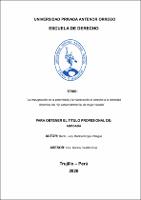| dc.contributor.advisor | Castilla Díaz, Karina | |
| dc.contributor.author | Rojas Villegas, Lucy Maribel | |
| dc.creator | Rojas Villegas, Lucy Maribel | |
| dc.date.accessioned | 2020-06-30T16:18:49Z | |
| dc.date.available | 2020-06-30T16:18:49Z | |
| dc.date.issued | 2020 | |
| dc.identifier.uri | https://hdl.handle.net/20.500.12759/6333 | |
| dc.description.abstract | Con la presente tesis trataremos de determinar de qué manera en un matrimonio la impugnación de la paternidad, vulnera el derecho a la identidad dinámica del hijo extramatrimonial de la mujer casada, en atención al principio del interés superior del niño.
Esta investigación está estructurada en siete capítulos. El capítulo I expone la introducción que consiste en el planteamiento del problema, enunciado, hipótesis, antecedentes y objetivos. El capítulo II se desarrolla la trascendencia del derecho a la identidad en la sociedad desarrollando la convención del derecho del niño y el derecho a la identidad. El capítulo III comprende la identificación del menor hijo concebido fuera del matrimonio por la esposa explicando lo que es paternidad y filiación. El capítulo IV comprende marco metodológico, en el que se describen el tipo de estudio y diseño; así como las técnicas e instrumentos de recolección de datos y métodos de análisis. En el capítulo V se desarrolla la propuesta legislativa. Finalmente, el capítulo VI contendrá las conclusiones y el capítulo VII, las recomendaciones.
La presente investigación tiene como objetivo principal determinar si la identidad dinámica del menor también debe ser valorada por el Juez al momento de resolver una acción de impugnación de paternidad, para lo cual se disgregará las dos vertientes del derecho a la identidad y se conceptualizará cada una de ellas, estableciendo sus semejanzas y diferencias.
La presente investigación es descriptiva. La metodología empleada es inductivo y deductivo. Los instrumentos utilizados para la recolección de la información fueron el método de revisión documental, elaboración de fichas y protocolo de contenido entre otros. Finalmente se arribó a la conclusión de que el derecho a la identidad debe ser entendido desde sus dos aristas (estática y dinámica), y no conceptualizarlo únicamente con la remisión al elemento biológico (identidad estática), pues se estaría dejando de lado la faz dinámica de la persona, que es más compleja y contiene múltiples aspectos vinculados entre sí, en atención al principio de interés superior del niño que va sopesar lo que es más beneficioso para el menor por ser el más vulnerable. | es_PE |
| dc.description.abstract | With this thesis we will try to determine how in a marriage the challenge of paternity affects the right of the dynamic identity of the extramarital child of the married woman, based on the principle of the best interests of the child.
This research is structured in seven chapters. Chapter I exposes the introduction that consists of the problem statement, statement, hypothesis, background and objectives. Chapter II develops the importance of the right to identity in society by developing the convention of the right of the child and the right to identity. Chapter III includes the identification of the minor child conceived outside of marriage by the wife explaining what paternity and filiation is. Chapter IV includes a methodological framework, which describes the type of study and design; as well as the techniques and instruments of data collection and analysis methods. Chapter V develops the legislative proposal. Finally, chapter VI will contain the conclusions and chapter VII, the recommendations.
The present investigation has as main objective to determine if the dynamic identity of the minor must also be assessed by the Judge at the time of resolving an action to challenge paternity, for which the two aspects of the right to identity will be disaggregated and each one will be conceptualized of them, establishing their similarities and differences.
The present investigation is descriptive. The methodology used is inductive and deductive. The instruments used for the collection of the information were the method of document review, elaboration of files and content protocol among others. Finally, it came to the conclusion that the right to identity must be understood from its two edges, and not conceptualized only with the remission to the biological element (static identity), since the dynamic face of the person would be neglected, which It is more complex and contains multiple aspects linked to each other. | en_US |
| dc.description.uri | Tesis | es_PE |
| dc.format | application/pdf | es_PE |
| dc.language.iso | spa | es_PE |
| dc.publisher | Universidad Privada Antenor Orrego | es_PE |
| dc.relation.ispartofseries | T_DER_495 | |
| dc.rights | info:eu-repo/semantics/openAccess | es_PE |
| dc.rights.uri | https://creativecommons.org/licenses/by/4.0/ | es_PE |
| dc.source | Universidad Privada Antenor Orrego | es_PE |
| dc.source | Repositorio Institucional - UPAO | es_PE |
| dc.subject | Paternidad | es_PE |
| dc.subject | Extramatrimonial | es_PE |
| dc.title | La impugnación de la paternidad y la vulneración al derecho a la identidad dinámica del hijo extramatrimonial de mujer casada | es_PE |
| dc.type | info:eu-repo/semantics/bachelorThesis | es_PE |
| thesis.degree.level | Título Profesional | es_PE |
| thesis.degree.grantor | Universidad Privada Antenor Orrego. Facultad de Derecho y Ciencias Politicas | es_PE |
| thesis.degree.name | Abogada | es_PE |
| thesis.degree.discipline | Derecho | es_PE |
| dc.subject.ocde | https://purl.org/pe-repo/ocde/ford#5.05.00 | es_PE |
| renati.type | https://purl.org/pe-repo/renati/type#tesis | es_PE |
| renati.level | https://purl.org/pe-repo/renati/level#tituloProfesional | es_PE |
| renati.discipline | 421016 | es_PE |
| dc.publisher.country | PE | es_PE |


